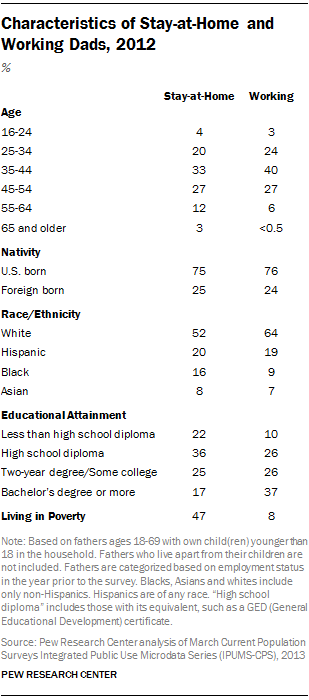
Among all fathers who live with at least one of their children, stay-at-home fathers are less well-off financially than their working counterparts. About half (47%) of fathers at home are living in poverty, compared with just 8% of those working outside of the home. The poverty rate of stay-at-home fathers is even higher than that among stay-at-home mothers (34%).
Overall, three-fourths (79%) of at-home fathers are married. Some 50% have wives who were employed during the past year, and 28% have wives who either did not work in the past year, or who were absent from the home. Another 15% of stay-at-home fathers are single, and 7% are cohabiting with a non-marital partner.8 While the plurality of stay-at-home fathers have a working spouse, among stay-at-home mothers, the share with a working spouse is much higher (68%)—and this may partially explain why poverty is even higher among stay-at-home fathers than stay-at-home mothers.
The high poverty rate among stay-at-home fathers may be further driven by their relatively low levels of educational attainment. More than half (58%) of fathers at home have a high school diploma or less, while this number is 36% among employed fathers. Some 22% of at-home fathers lack a diploma, as compared with 10% of employed fathers. About the same share of at-home fathers and employed fathers have some college experience or a two-year degree, but just 17% of at-home fathers have earned a bachelor’s degree, as compared with 37% of working fathers.
About half (52%) of stay-at-home fathers are white, while 20% are Hispanic, and 16% are black. By comparison, 64% of employed fathers are white, 19% are Hispanic, and 9% are black. Asians comprise 8% of at-home fathers, and 7% of working fathers. Both stay-at-home fathers and working fathers are equally likely to be foreign-born—about one-fourth are. While the race and ethnic profiles of at-home and working fathers mirrors those of mothers, the nativity profiles are different; a disproportionate share of foreign-born mothers are stay-at-home moms.
Stay-at-home fathers are quite a bit older than working fathers. While 43% of stay-at-home fathers are ages 45 years or older, this share is 33% among employed fathers. This is in stark contrast to the pattern among stay-at-home moms, who tend to be younger than their counterparts in the workforce.




